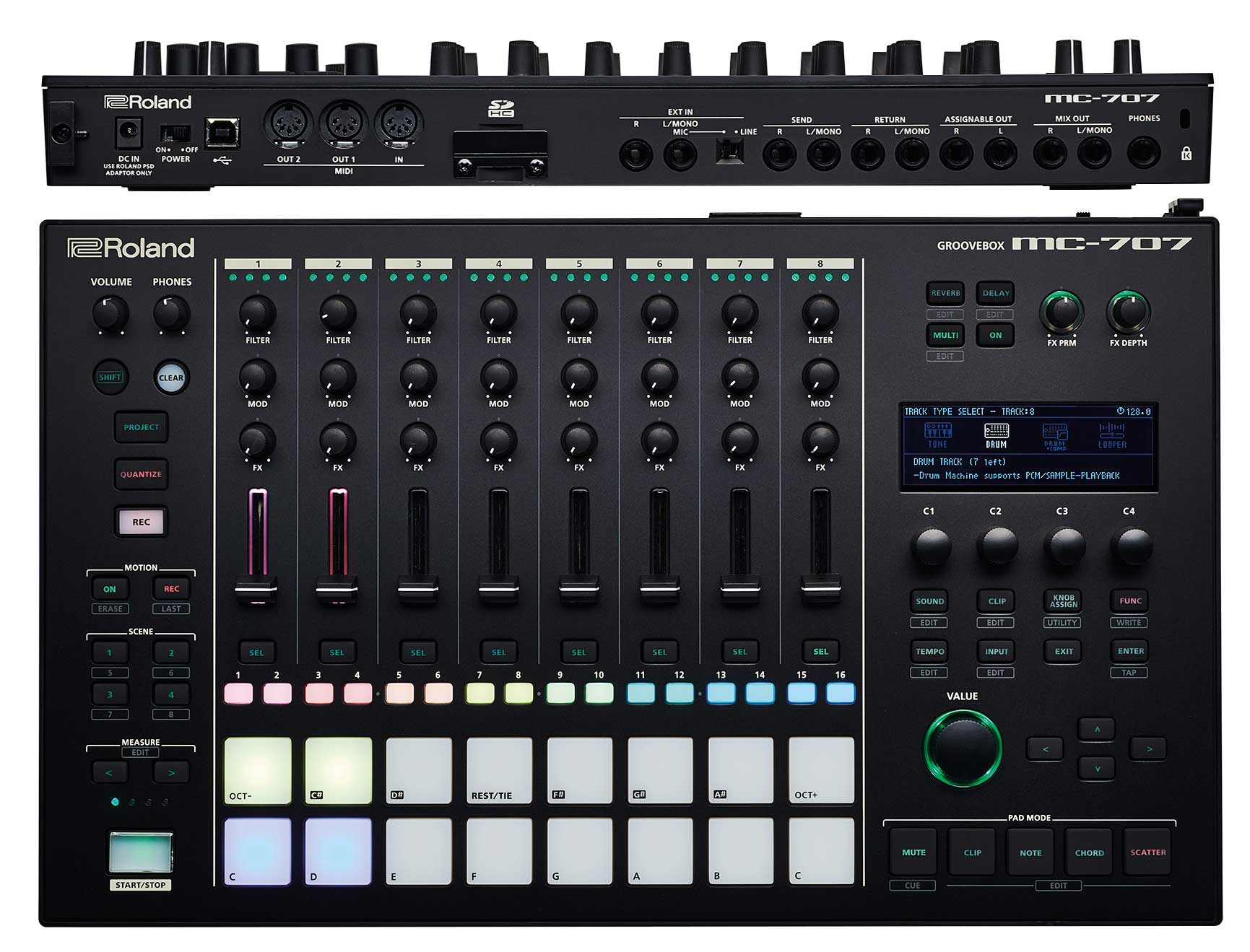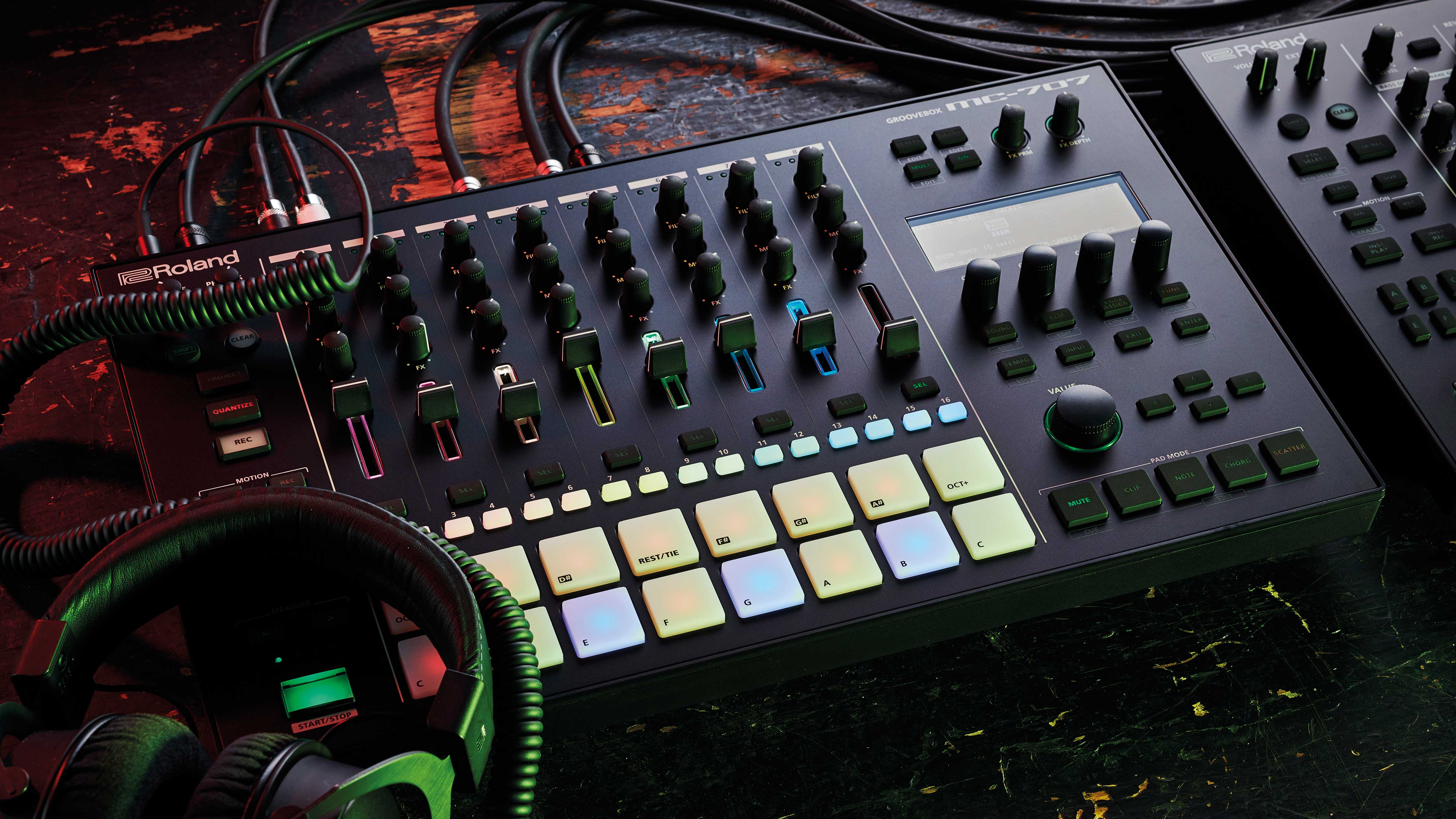MusicRadar Verdict
It lags behind some rivals on the sampling front, but on the whole, the MC-707 is powerful, well-designed and a lot of fun.
Pros
- +
Packed with lots of quality sounds.
- +
Great effects, plus external send/return loop.
- +
Very well thought-out workflow.
Cons
- -
No one-shot sampling or loop-slicing.
- -
Lots of menu-diving.
MusicRadar's got your back
Roland’s MC range of all-in-one grooveboxes has lain dormant since the release of the MC-808 in 2007. Much like their counterparts in Akai’s MPC line, these sampler and synth-equipped sequencers fell out of favour with much of the general public as music-making software became more powerful and modern tools like Ableton Live and NI Maschine made hardware solutions look old hat.
However, over a decade on there’s a new interest in ‘studio in a box’ tools that allow electronic musicians to produce and perform full tracks without a computer.
With the success of their recent MPCs and Force, Akai have proved that mass-market production stations can stand up against a DAW. No surprise, then, that Roland have chosen now to breathe new life into the MC line. While the name and basic principle is the same, the MC-707 isn’t simply an update to those earlier grooveboxes.
From sketching the foundations of a club track to acting as the centrepiece of a live setup, this latest MC ticks a lot of boxes
The MC-707 lands as a member of the brand’s Aira line, and design-wise it’s more like the recent TR-8S than the MC-808 or MC-909. (And no, there’s no D-Beam here; for better or worse!)
In terms of size and weight, the 707 is almost identical to the TR-8S. Its layout is fairly similar too, with the central area occupied by a bank of channel strips made up of faders and rotaries. The major difference, interface-wise, is that the TR-8S’ chunky step-sequencing buttons are replaced here by a bank of 16 rubber performance pads with a considerably smaller step-sequencer row above them.
Also, the right-hand side of the 707’s panel is occupied by a screen and range of selection buttons used to navigate the instrument’s various menus, parameter pages and arrangement tools.
In total, the MC-707 offers eight tracks, controlled and edited via its central bank of channel strips. Each track can be assigned either a Tone (polyphonic instrument), Drum (multi-part drum kit) or Looper (audio recorder). Recording and sequencing of these elements is then handled by the pads and sequencer buttons, to create Clips, which are recorded, arranged and played using a grid system like Ableton Live’s Clip View.

ZEN-Core
Both Drum and Tone generators make use of Roland’s new ZEN-Core engine, using a mixture of PCM samples and virtual analogue. That means there’s no Analog Circuit Behaviour (ACB) tech – the much hyped engine used for the Boutique range and the TR-8S’s drum emulations.
Despite this, the MC-707 is packed with sounds from Roland’s past, which on the whole sound excellent. There are multiple varieties of drum kits based around sounds from each of the company’s classic groove boxes and instrument patches that take influence from Junos, Jupiters, 101 basslines and more.
In total there are more than 3,000 Tone presets and 80 preset Drum kits, each made up of 16 individual drum sounds. The Tone and Drum generators are more than just preset players though; each has a decent amount of sound shaping parameters. Drum sounds can have each individual sample tune shaped, while the Tone engine offers a simple subtractive synth engine, whereby the source sound can be filtered, shaped and have effects applied.
For authenticity, this engine is a slight downgrade compared to the full component-modelling of the Boutiques’ ACB engines, but – as Roland explain – it allows for a much higher level of polyphony from the hardware (a max of 128 voices). There’s more customisation too, as users can import their own samples via USB to act as sources for Drum and Tone tracks.
The Looper tracks are probably the least developed element of the 707 at present. These allow users to capture audio, either from the device’s external inputs, the USB audio connection or from another track internally, and loop it as a clip within the 707’s arrangement workflow. There are then edit controls to adjust the pitch, speed and duration of loops.
Where the 707 lags behind some rivals is the lack of one-shot sampling or loop slicing. This means it’s currently not possible to, say, grab a vocal stab from a vinyl record and sequence it using the step sequencer, or chop up and retrigger a sampled drum loop without bumping the file to a computer first. It sounds like these features are on Roland’s ‘to do’ list for future updates, but it feels like the most notable hole in the MC-707’s workflow right now.
Effects 'best of'
One area where the MC-707 really shines is its effects. As with the TR-8S, these are divided into track and master effects. Each track has a multi-effect slot that can make use of processors from 90 options, covering everything from EQ and filtering to multiple varieties of reverb and delay model, compression, distortion and plenty of modulated processors.
The list of effects is essentially a ‘best of’ of recent Roland gear with a few interesting new tools chucked in. The MC-707 also has I/O for an external effects loop, and each track can be routed to this before being finished off with a track EQ module. At the master level, the MC-707 has five effects slots – one master compressor, an EQ, reverb and chorus/delay send effects, plus a generic multi-effect slot that can draw from the same list as the track effects.
The Aira range’s Scatter effect makes a return here too, selected via the bank of 16 pads. I wasn’t that fussed on the whole Scatter concept when I first heard it on the original Aira range, writing it off as a bit of a generic beat-repeat tool. It’s become considerably more interesting in recent iterations, however, with some interesting granular sound mangling effects on offer. It works particularly well here, coupled with the ability to resample to Looper tracks, allowing users to capture clips of audio with weird rhythmic effects baked-in.
The arrangement workflow is neat too. As mentioned, it uses a clip-based workflow that users of Ableton Live will feel at home with. Each track can contain up to 16 clips that can then be triggered either individually or as groups. As well as audio or note info, clips also contain parameter modulation, effects settings and Tone or Drum patches, meaning they can be used to switch between totally different sounds across a single track, which significantly widens the potential for using the MC-707 as a live tool.
There’s no way to automatically string clips together into a full song or arrangement, so no way to export full projects. This is no huge issue though; the device can stream individual tracks as audio via USB, so there’s a relatively simple bridge for getting work created on the hardware recorded in a DAW.
The same goes for the lack of individual track outputs – if you need to get every channel out of the 707 individually, it can be done via USB, but as a live tool it makes sense to use it as a central mixer anyway. Personally I’d rather have the external effects loop than use that space for additional outputs.
In all then, the MC-707 is a nicely designed tool, and a welcome return to this corner of the market for Roland. Workflow-wise, there are some niggles; the lack of one shot sampling, mainly, but there’s also a lot of menu diving. Compared to Akai’s MPC Live, with its large touchscreen, Roland have crammed a lot of under-the-hood parameters into a relatively small display. While this means workflow feels more focussed on the hardware itself, it also results in a fair amount of shift-pressing and scrolling through sub-menus.
Personally, I find the response on the pads a little heavyweight too – maybe I’m just weak, but I had to bash them to get a decent velocity level. This is fine for playing drum kits, but lacks nuance for Tone instruments. You can change the responsiveness in the settings, but I still found myself resorting to using fixed velocities and editing later.
On the whole though, the MC-707 is powerful and well-designed, and we can see it becoming a creative hub for a lot of producers. From sketching the foundations of a club track to acting as the centrepiece of a live setup, this latest MC ticks a lot of boxes. Welcome back Roland.
I'm the Managing Editor of Music Technology at MusicRadar and former Editor-in-Chief of Future Music, Computer Music and Electronic Musician. I've been messing around with music tech in various forms for over two decades. I've also spent the last 10 years forgetting how to play guitar. Find me in the chillout room at raves complaining that it's past my bedtime.
“I used everything I knew about music”: How Green Day exceeded expectations with their most ambitious song
YouTube just added AI tools that makes musicians, library music and video editors redundant
“Every one of them said yes without hesitation": Hank Marvin and Roger Taylor have just remade a '60s classic for charity










